Growing herbs indoors is a great way to keep their fresh flavor at your fingertips all year long. With the right setup, many popular herbs will grow inside, providing a constant supply to use in your recipes.
It’s important to choose varieties that adapt well to indoor conditions. Basil, rosemary, parsley, and chives are popular choices, but other herbs can be grown indoors if they receive the proper light and care.
This guide explains how to choose the best herbs and care for them indoors. By following these steps, you can create an indoor herb garden that will help you add flavor to recipes year-round.
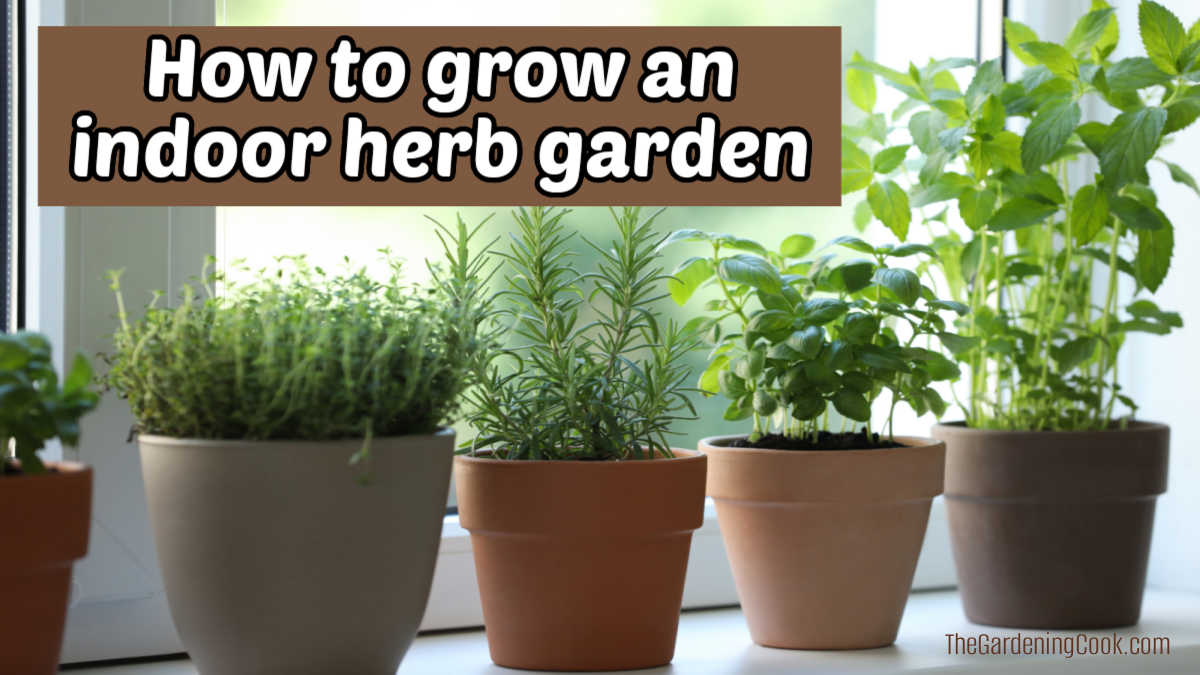
Herbs that grow well indoors
Not all herbs thrive in indoor conditions, so choosing the right varieties is the first step to success. The herbs below adapt well to containers, grow quickly with the right care, and provide lots of fresh flavor to your recipes.
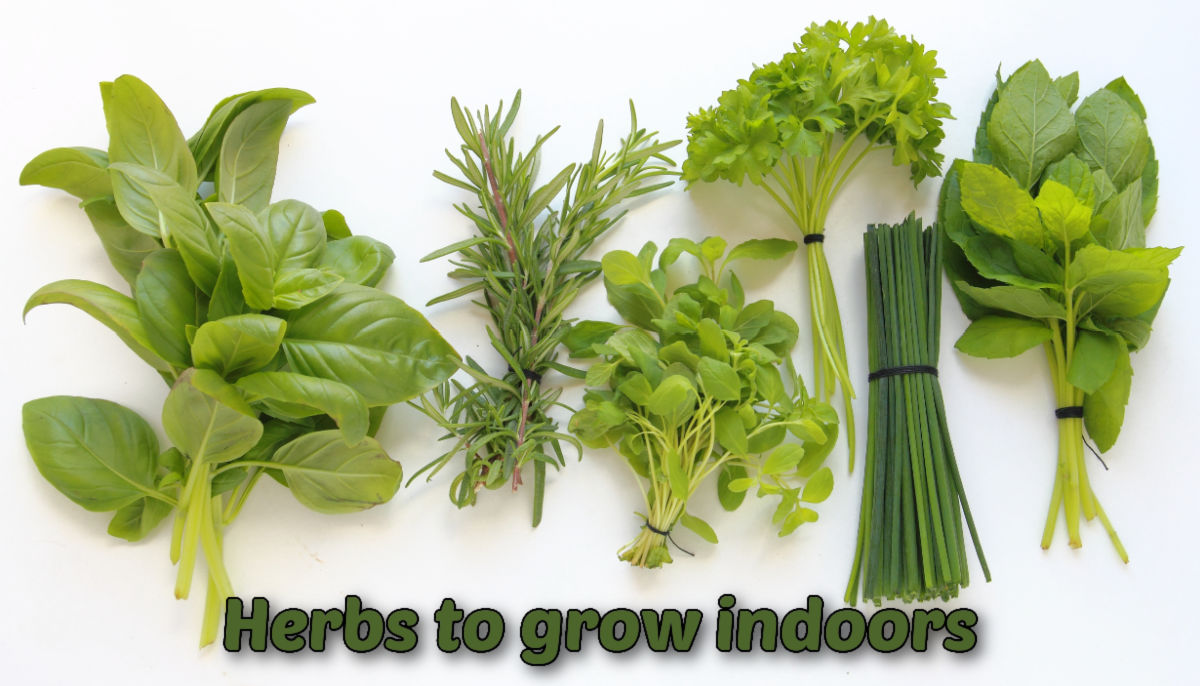
- Basil – grows well in warm, sunny spots
- Parsley – adapts to partial sunlight
- Chives – fast growing and easy to maintain
- Mint – spreads easily
- Thyme – likes a sunny windowsill
- Rosemary – thrives under grow lights
- Tarragon – French tarragon has the best flavor
- Sage – give it a sunny window or grow lights
- Cilantro – grows quickly but has a short life cycle
The main consideration for you to keep in mind when choosing which herbs to grow indoors is the amount of sunlight available. Size also matters, since some herbs grow faster than others.
What you will need for indoor herb gardens
Even though most herbs stop growing in the colder months, that does not mean our demand for them decreases. The good news is that you can use fresh herbs in cooking all year round by having an indoor herb garden.
To grow herbs indoors, you’ll need a few basic supplies:
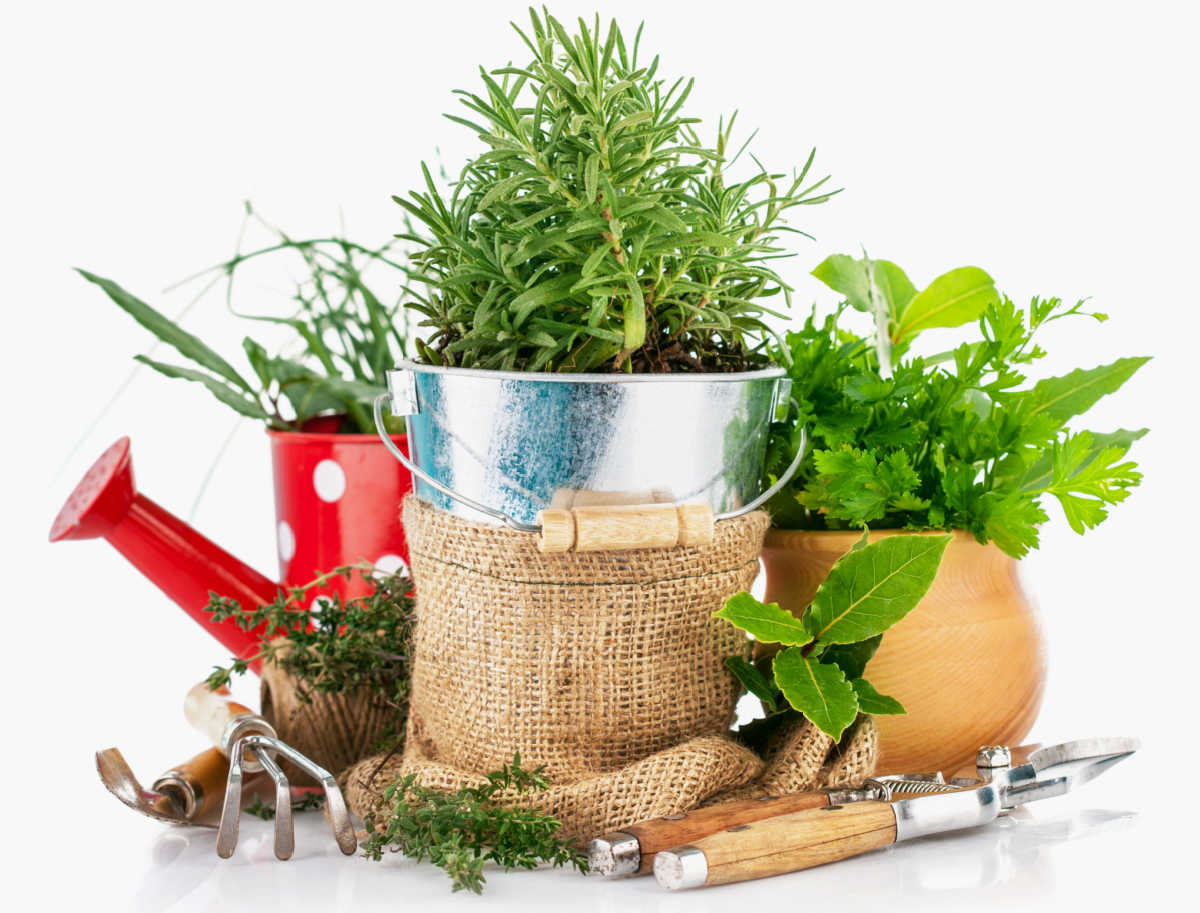
- Containers with drainage holes
- High-quality potting mix
- Watering can
- Access to natural light or grow lights
- Fertilizer suitable for herbs
- Garden tools for herbs
How to start growing herbs indoors
Starting an indoor herb garden is easier than it looks, but a few key steps will set your plants up for long-term success. Follow these guidelines to give your herbs the light, soil, and care they need to thrive inside.
Choose the location for your indoor herb garden
All herbs need a sunny location to grow well. Place herbs where they’ll get at least 6 hours of bright light daily. A south-facing window is ideal.
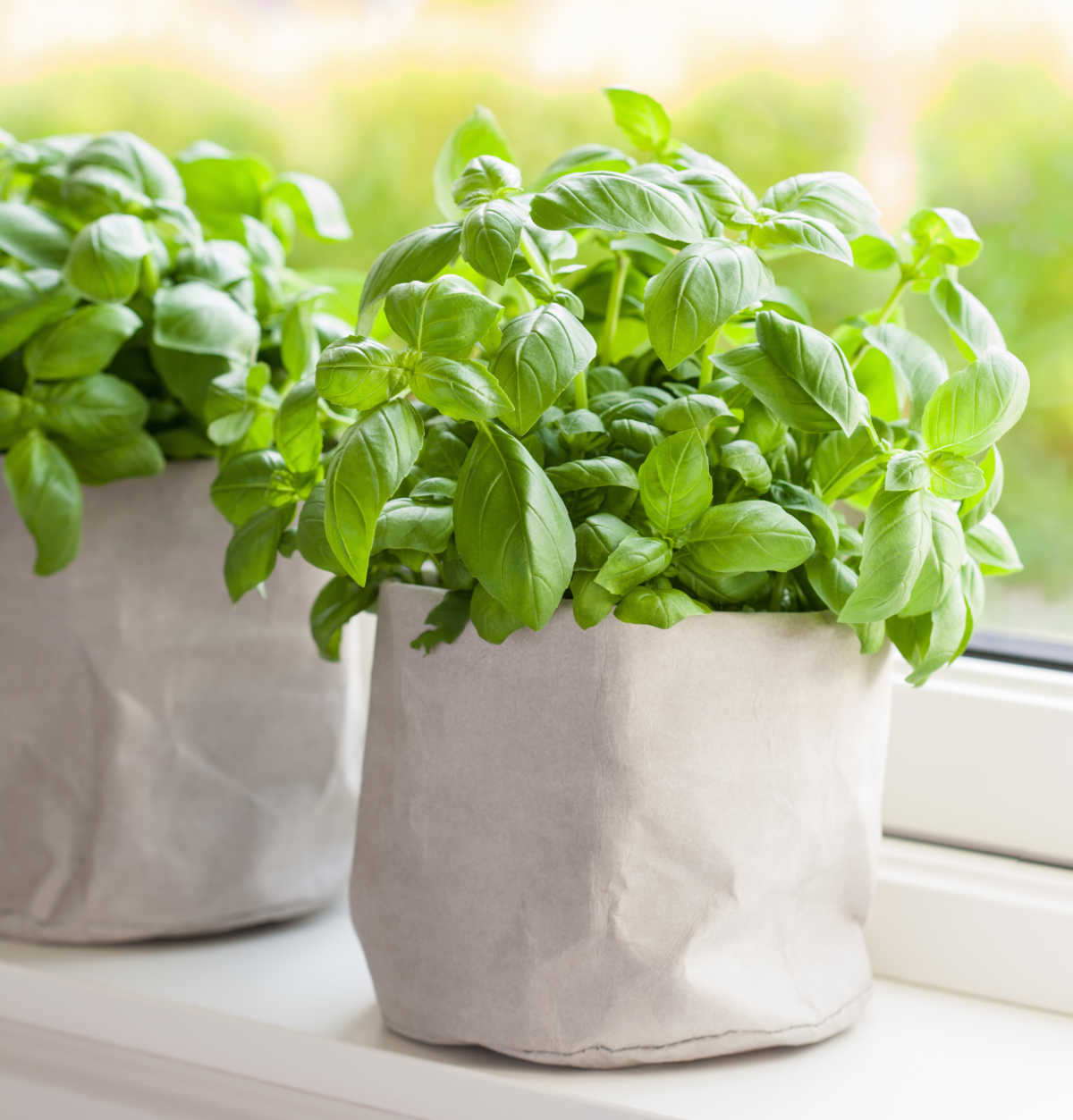
If natural light is limited, you can supplement the light with grow lights set on a timer.
It is easy to tell if your indoor herbs are getting enough light. If the new growth reaches towards the light and gets spindly, the herb plant is telling you to move it to a sunnier spot.
Rotating the containers weekly will also ensure that the light is delivered evenly and that the herbs will grow upright.
Temperature issues when growing herbs indoors
Herbs don’t like the cold temperatures. Most herbs have thin leaves, and this type of plant will die easily if it gets too cold. Be sure that the inside temperature of your home is between 65ºF – 75ºF (18C to 24C).
When it’s cold outside, keep herbs away from drafts and cold window panes. Also, be sure to keep herbs away from heating vents so you don’t overheat them.
Use containers that drain well
Herb plants like well-draining soil. The fastest way to kill an indoor herb garden is to overwater the herbs, or have the plants sitting in saucers of water so that the roots are constantly wet.
Choose pots with drainage holes to prevent water from pooling near the roots.
You can use a combination of small pots with single herbs or larger containers that will hold several herbs.
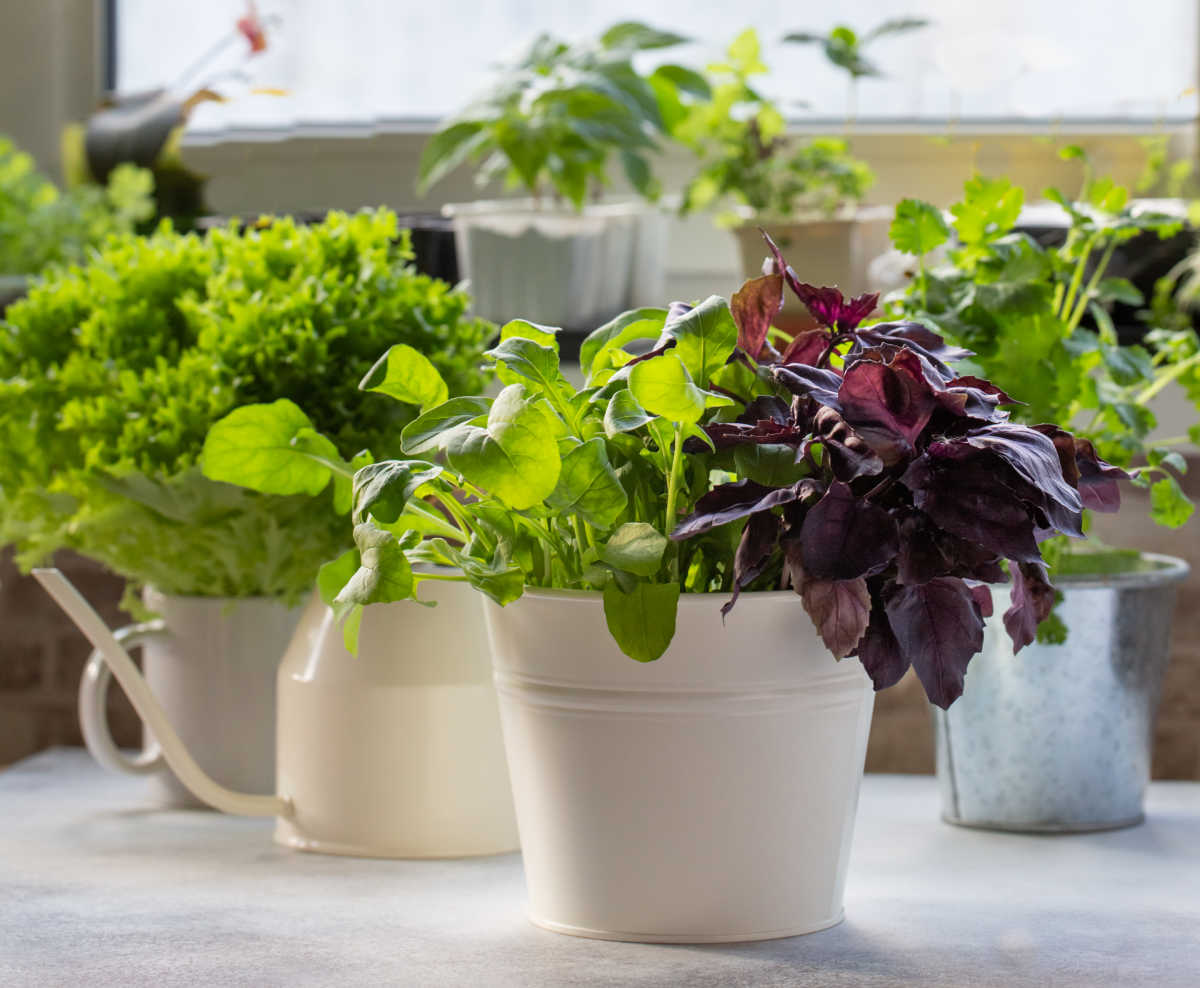
Be sure to use saucers to protect your furniture, and remember that clay pots and saucers are porous and will leave water stains on your furniture. Plastic, rubber, and glass pots are the best containers to use for indoor herbs.
Use a good quality potting mix for herbs
Choose a lightweight, well-draining potting mix designed for container plants. Adding perlite or vermiculite can improve drainage for herbs like basil, rosemary, and thyme.
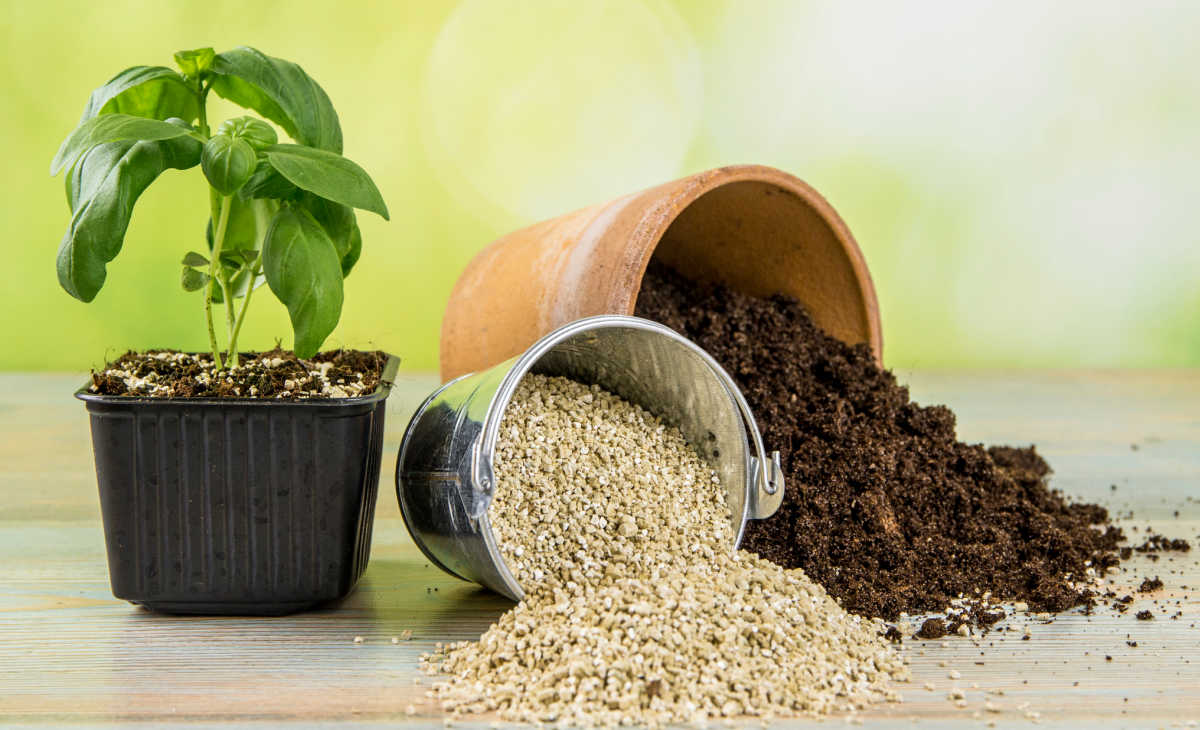
Don’t use garden soil. This type of soil compacts too easily indoors and does not drain well in pots.
Plant seeds or transplants
You can plant seeds or buy small pots of herbs from a garden center.
Seeds are slower to grow, but more cost-efficient. Lightly press herb seeds into potting mix and keep them moist until germination.
You can also take cuttings of herbs you have growing outdoors and allow them to root.
Water herbs carefully
It is important to make sure that your indoor herb plants are watered regularly. Don’t allow them to dry out, but also take care not to overwater them.
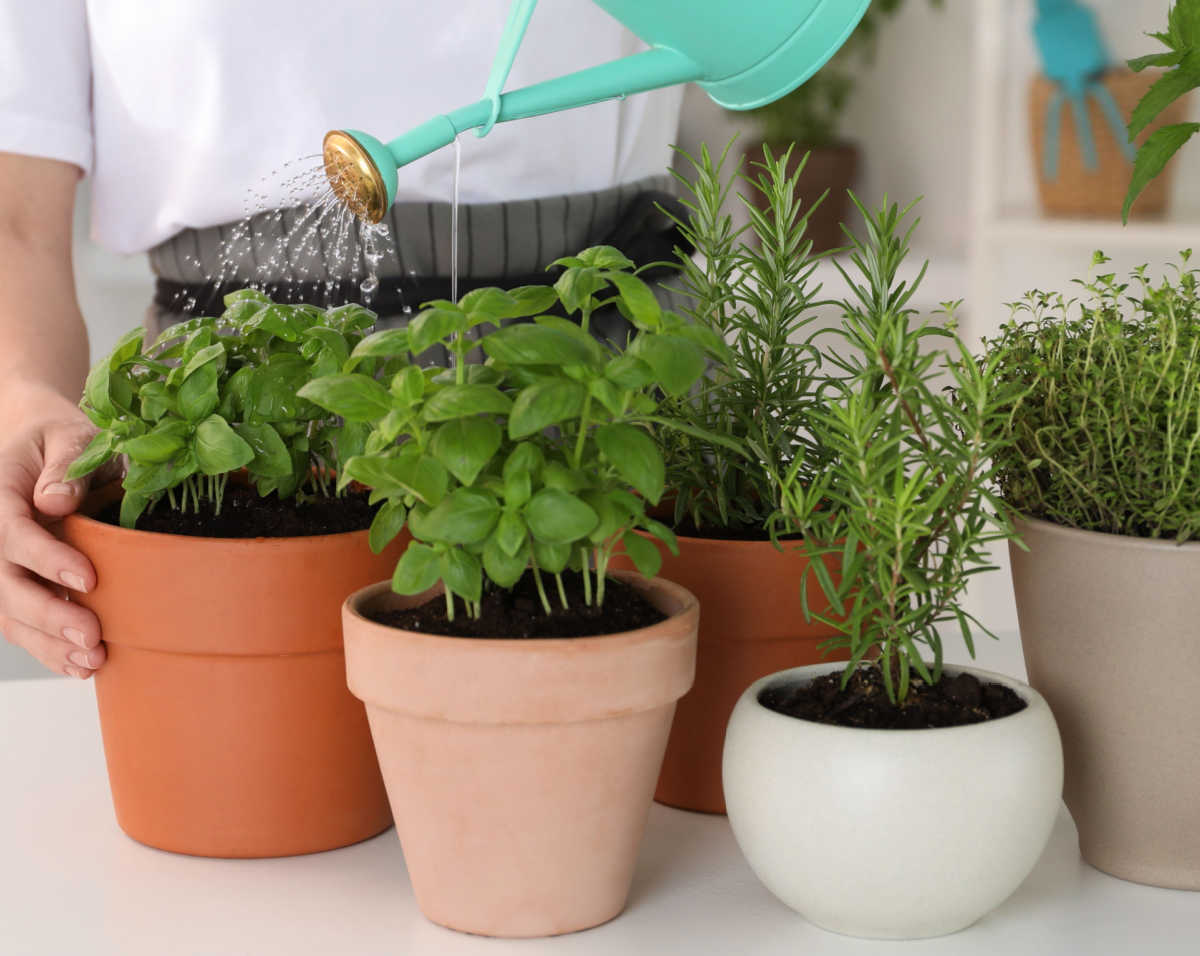
A good rule of thumb for many house plants, including herbs, is to water when the first inch of the soil starts to feel dry. You can test this with your fingertips.
If the area just below feels moist but the top is dry, it’s time to add a bit more water.
How to get the right humidity for your herb plants
The air in most homes is quite dry, particularly during the winter. A good way to ensure that your indoor herb gardens get the right humidity is to use a humidity tray.
Place the pots on a long tray that has a layer of pebbles or rocks in it. Keep water lower than the height of the stones.
This will make a more humid area around the plants. Plant misters are also great for adding humidity to individual plants.

Provide nutrients to indoor herbs
A good water-soluble indoor plant fertilizer at half-strength should be used once a month to help the herbs get the right nutrients. Too much fertilizer can cause herbs to become weak with leggy growth. Light feedings are best.
It’s also easy to make a DIY plant fertilizer, which can be used to feed herbs.
Harvest regularly
Herbs grown indoors have a tendency to be a little more spindly than those grown outside, due to the lesser light conditions. Pinching out the tips is a way to encourage bushiness.
Since you will be snipping off stems to use in cooking, this job will almost take care of itself!

Don’t remove more than 1/3 of a plant at one time, or the herbs will become stressed.
Regular harvesting also prevents herbs from flowering too soon, which can make them more bitter. It’s good to pinch off any flowers that form.
Troubleshooting common problems
In spite of your best efforts, things don’t always go to plan. Here are some problems you may encounter and how to deal with them.
- Leggy growth – They are not getting enough sunlight. Move the herbs to a sunnier location or use grow lights.
- Yellow leaves – Overwatering or a nutrient deficiency. Water less, or add some fertilizer.
- Slow growth – It may be too cold or the soil is not suitable for growing herbs indoors. Repot in good quality soil.
- The herbs are dying after transplant – Start over with new plants.
- Herbs taste bitter – If they have flowered, this can cause bitterness. Pinch off the flowers when they appear.
- The herbs have bugs in them – Aphids, mealybugs, thrips, whiteflies, and spider mites can be a problem. If found, treat them with neem oil.
Growing herbs indoors free printable
If you’d like a reminder of how to grow herbs indoors, you can print out this list of care tips in a high-resolution image here. You can also get the care tips from the project card at the bottom of the post in a slightly smaller size.
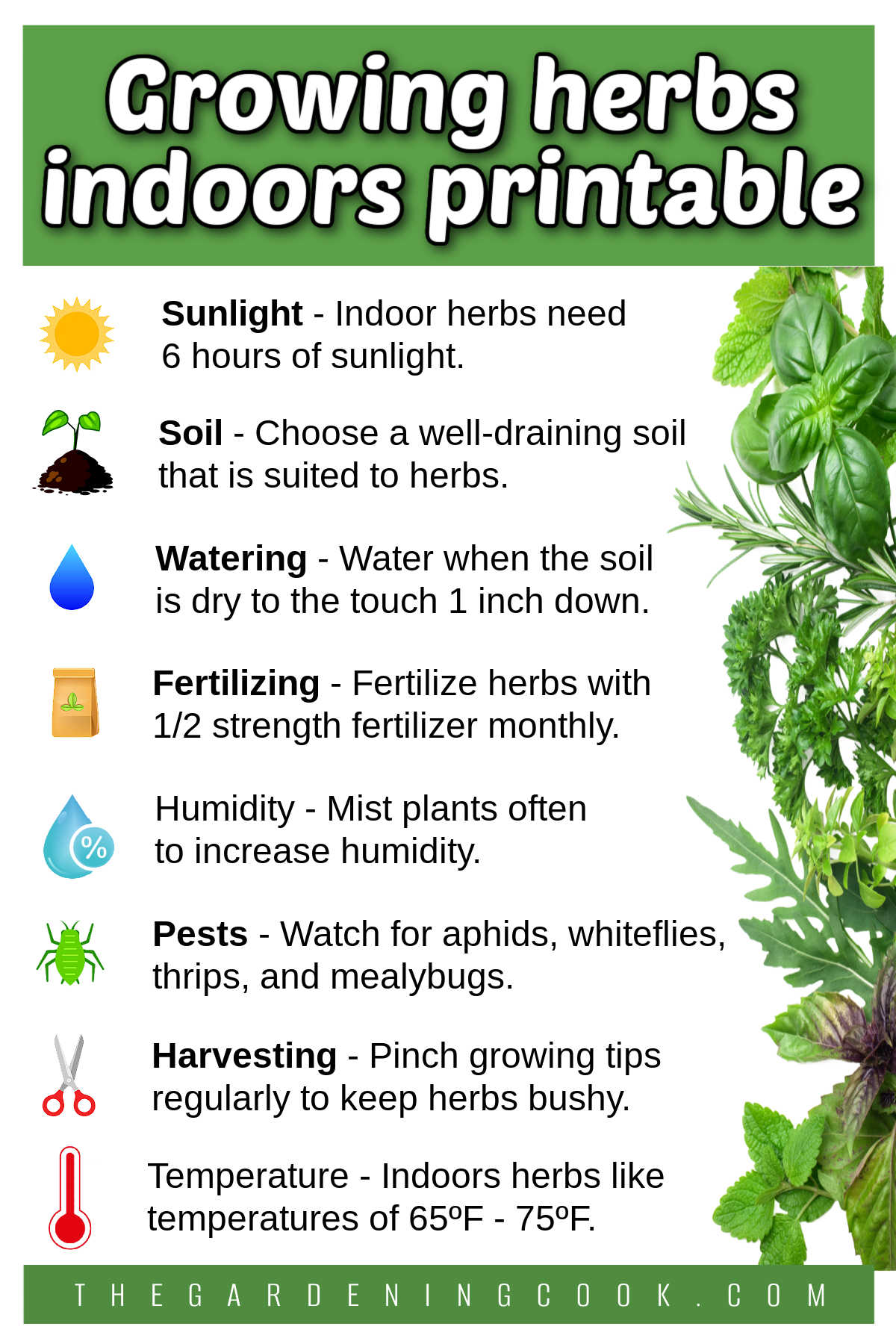
Share this guide for growing herbs indoors on X
If you enjoyed learning how to grow an indoor herb garden, why not share this guide with a friend? Here is a post to get you started:
Do you use fresh herbs in recipes? 🌿 Head to The Gardening Cook to learn how to grow herbs indoors so that you can enjoy the flavor of fresh herbs all year long. 🌱 #HerbGardening #IndoorGarden #GrowingHerbs #GardeningTips… Share on XPin this post for growing herbs indoors
Would you like a reminder of this post on how to grow an indoor herb garden? Pin this image to one of your gardening boards on Pinterest so that you can easily find it later.
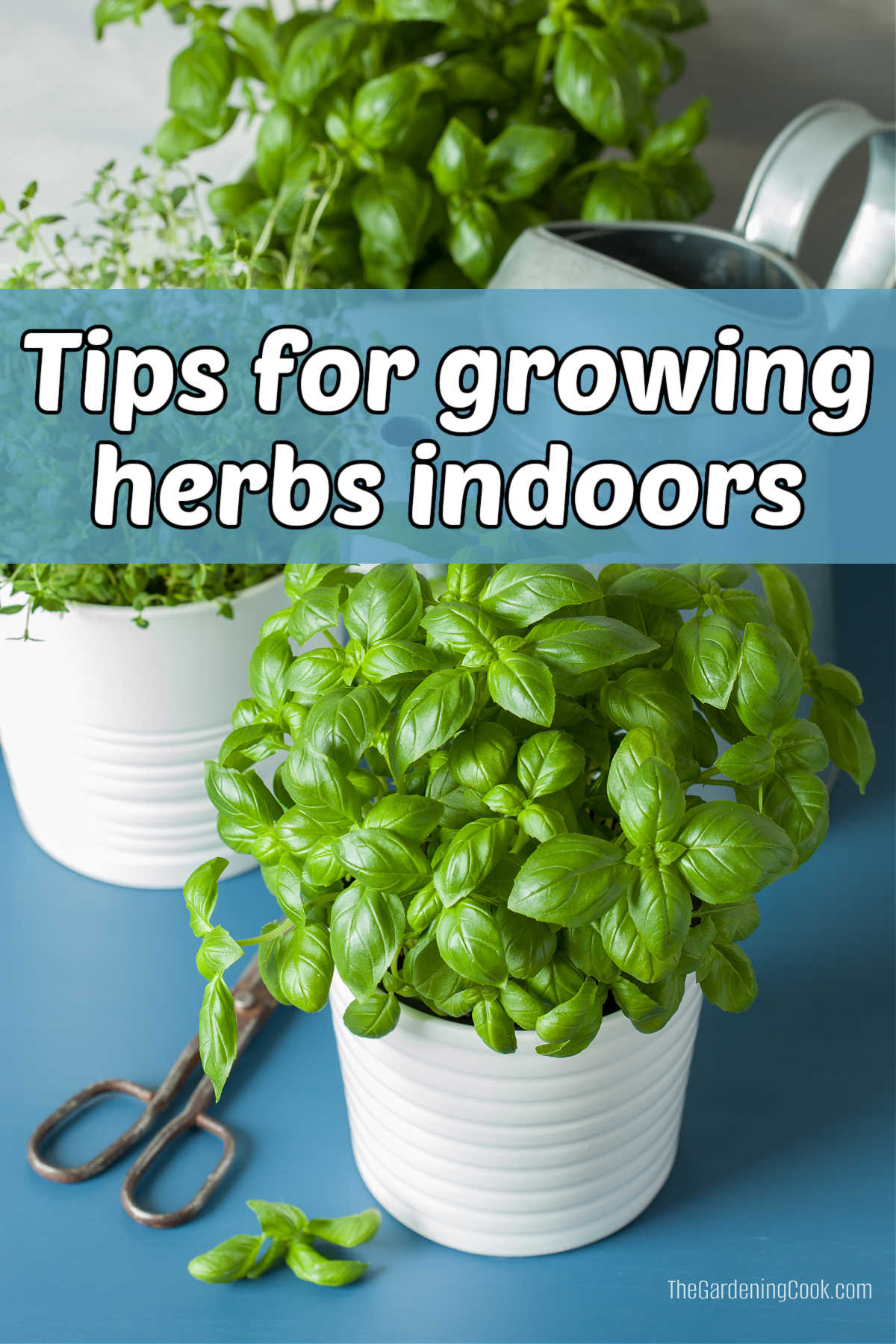
Admin note: This article on how to grow herbs indoors first appeared on the blog in October 2017. This post has been updated to add new photos, more tips for growing herbs, and a slideshow video.
Growing Herbs Indoors Free Printable
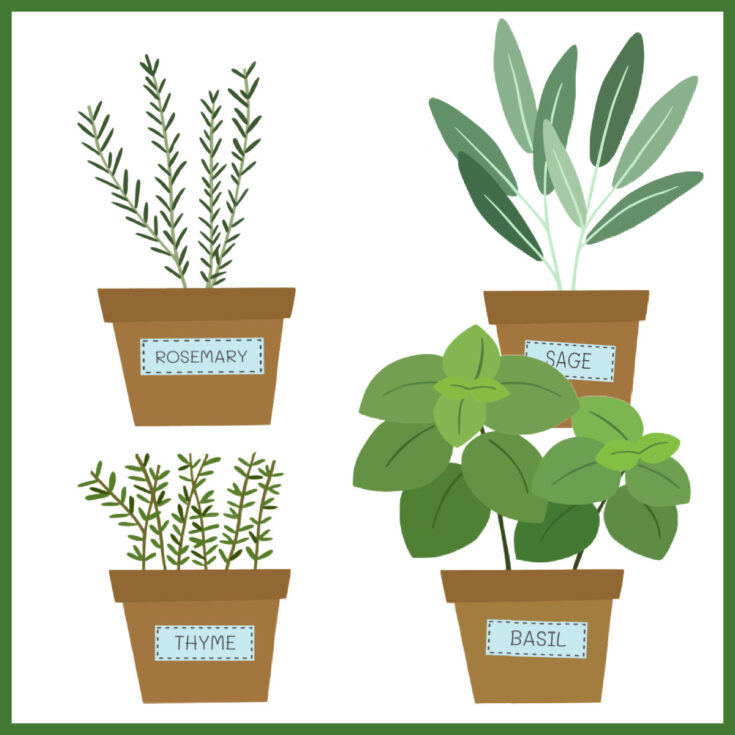
Growing herbs indoors is a great way to keep their fresh flavor handy all year long.
Download this printable showing how to care for indoor herbs and save it for future reference.
Materials
- Printer paper
Tools
- Computer
- Printer
Instructions
- Load your computer paper into your printer.
- Using the print function on this card will give you a list of indoor herb garden care tips that fills about 3/4 of an 8.5 x 11-inch sheet of paper.
- Choose portrait layout and, if possible, "fit to page" in your settings. Doing this will fill the entire page.
- Alternatively, you can use this link to print the indoor herb garden infographic as a high-resolution image, using the print feature in your browser window.
- After you get this list of plant care tips, you can use them for future reference.
- Please note: Free gardening printables take a long time to make. This list of indoor herb care tips is for personal use only. If you are sharing this list (and thank you for that!), please link directly to this post and not to the actual image. We appreciate your help in supporting the site. This gardening printable may not be used for any retail purpose or mass distribution.
Notes

Recommended Products
As an Amazon Associate and member of other affiliate programs, I earn from qualifying purchases.


